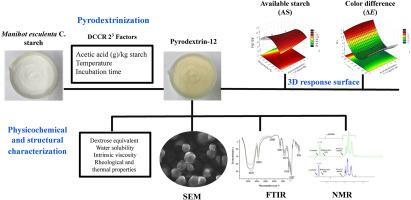Physicochemical and structural changes of cassava starch modified by pyrodextrinization with glacial acetic acid as catalyst
IF 3.8
Q2 BIOTECHNOLOGY & APPLIED MICROBIOLOGY
引用次数: 0
Abstract
This article aimed to produce pyrodextrins from cassava starch (Manihot esculenta C.) using glacial acetic acid (CH3COOH) and to analyze the effects of the modification on the physicochemical and structural properties. The central composite rotational design (CCRD) was carried out, using an α = ± 1.68 to generate 19 total trials (8 factorial points, 6 axial points, and 5 repetitions in the central point) to evaluate the effects of acid concentration (0.58–6.70 g acid/kg starch on a dry basis), temperature (100–200 °C) and incubation time (29–331 min) on pyrodextrins. Pyroconversion was carried out by spraying the acid solution on the starch powder. The response variables were available starch (AS) content and color difference (ΔE) index. Morphological, structural, thermal, rheological, and physical characterization analyses were then carried out. Pyroconversion reduced (P < 0.05) the AS content between 4.4ー42.2 % with minor changes in the ΔE index, except for Pyrodextrin-12, prepared with 3.64 g/kg heated at 200 °C for 180 min, the least digestible and darkest pyrodextrin. Pyrodextrins 8 and 12 were cream-yellow colored, water-soluble and low viscous materials. IR and NMR spectra of pyrodextrins showed a reduction in the presence of the α(1,4) glycosidic bond typical of starch, indicating a change in its chemical structure. CH3COOH proved to be an efficient acid for reducing the in vitro digestibility of cassava starch by pyroconversion, without drastically changing the color of pyrodextrin.

冰乙酸催化焦糊化改性木薯淀粉的理化及结构变化
以木薯淀粉(Manihot esculenta C.)为原料,采用冰乙酸(CH3COOH)制备焦糊精,并分析了改性对其理化性质和结构性能的影响。采用中心复合旋转设计(CCRD),采用α =±1.68,共19个试验(8个析因点、6个轴向点、5个中心点重复),评价酸浓度(干基0.58 ~ 6.70 g酸/kg淀粉)、温度(100 ~ 200℃)和培养时间(29 ~ 331 min)对焦糊精的影响。将酸溶液喷在淀粉粉上进行热转化。响应变量为有效淀粉(AS)含量和色差(ΔE)指数。然后进行形态、结构、热、流变和物理表征分析。热转化使AS含量降低(P < 0.05),在4.4 ~ 42.2%之间,ΔE指数变化不大,但除焦糊精-12外,其含量为3.64 g/kg,在200℃下加热180 min,是最难消化、颜色最深的焦糊精。焦糊精8和12为米黄色、水溶性、低粘性物质。焦糊精的红外和核磁共振光谱显示,淀粉典型的α(1,4)糖苷键的存在减少,表明其化学结构发生了变化。CH3COOH被证明是一种有效的酸,可以通过热转化降低木薯淀粉的体外消化率,而不会显著改变焦糊精的颜色。
本文章由计算机程序翻译,如有差异,请以英文原文为准。
求助全文
约1分钟内获得全文
求助全文
来源期刊

Biocatalysis and agricultural biotechnology
Agricultural and Biological Sciences-Agronomy and Crop Science
CiteScore
7.70
自引率
2.50%
发文量
308
审稿时长
48 days
期刊介绍:
Biocatalysis and Agricultural Biotechnology is the official journal of the International Society of Biocatalysis and Agricultural Biotechnology (ISBAB). The journal publishes high quality articles especially in the science and technology of biocatalysis, bioprocesses, agricultural biotechnology, biomedical biotechnology, and, if appropriate, from other related areas of biotechnology. The journal will publish peer-reviewed basic and applied research papers, authoritative reviews, and feature articles. The scope of the journal encompasses the research, industrial, and commercial aspects of biotechnology, including the areas of: biocatalysis; bioprocesses; food and agriculture; genetic engineering; molecular biology; healthcare and pharmaceuticals; biofuels; genomics; nanotechnology; environment and biodiversity; and bioremediation.
 求助内容:
求助内容: 应助结果提醒方式:
应助结果提醒方式:


